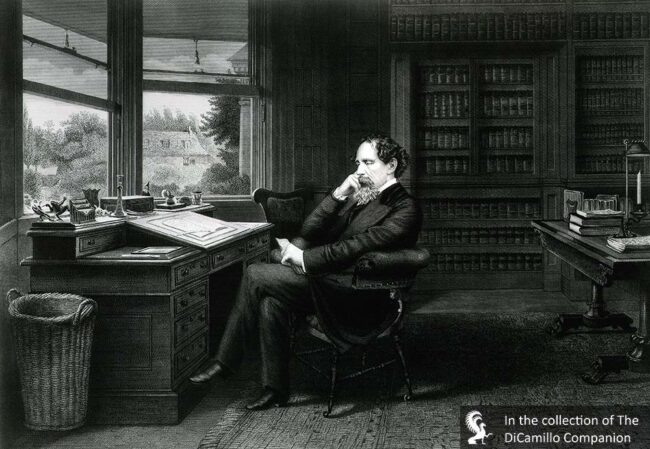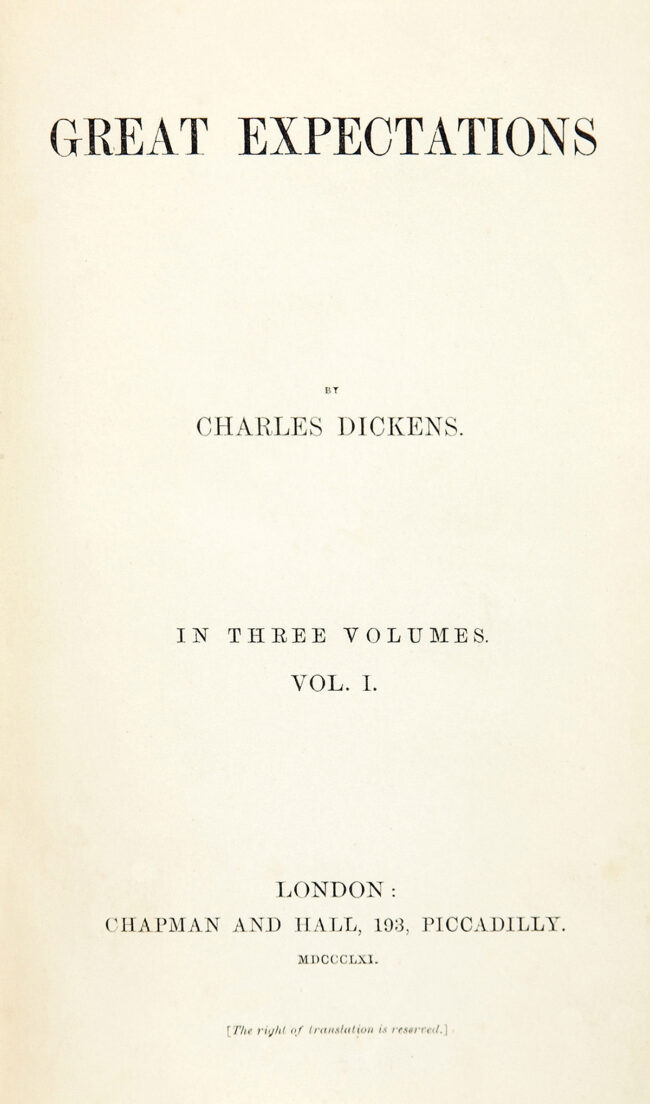
"Charles Dickens in His Study at Gadshill," from a circa 1875 engraving by Samuel Hollyer.

The title page of Volume I of the first (1861) edition of "Great Expectations." Dickens wrote the famous story at Gads Hill. This image is in the public domain.
Built / Designed For: Thomas Stevens
House & Family History: Gads Hill Place was built as a three-bay suburban villa in the late 18th century for Thomas Stevens, former mayor of nearby Rochester. After passing through a number of owners, the house was purchased in 1856 for £1,770 by Charles Dickens from fellow author Eliza Lynn (equivalent to approximately £1.2 million in 2016 inflation-adjusted values using the labour value commodity index). Gads Hill was a love story for Dickens. He first saw the house in 1821, when, as a nine-year-old, he walked past it with his father. For decades he dreamed of living here; in later life Dickens wrote "I used to look at it as a wonderful Mansion (which God knows it is not) when I was a very odd little child with the first faint shadows of all my books in my head—I suppose." It was the only house he ever owned. Here Dickens wrote much of "A Tale of Two Cities," "Great Expectations," "Our Mutual Friend," and the unfinished "The Mystery of Edwin Drood." Gads Hill was mentioned by Dickens in "A Christmas Carol," where it was described as "a mansion of dull red brick with a little weather-cock surmounted Cupola on the roof and a bell hanging in it," and the Higham area, where Gads Hill Place is located, was the setting for the opening scenes of "Great Expectations." Dickens entertained many of the leading authors and artists of his day at Gads Hill, including William Powell Frith, Henry Wadsworth Longfellow, Charles Allston Collins, Marcus Stone, Wilkie Collins, and Hans Christian Andersen. The latter came to stay in 1857 for what turned out to be a friendship-ending visit. Andersen had been invited for three days and stayed for five weeks, which resulted in the famous Danish author finally being asked to leave. On June 9, 1870 Dickens died in the dining room at Gads Hill. After a number of subsequent owners, including Charles Dickens, Jr., in 1924 the house became a residential school for girls. Gads Hill School, today a co-educational independent day school, continues to teach seniors on the upper floor of the house; the remaining students are taught in a new building that was erected in 2010 on the grounds. The school has maintained Dickens's study as it was when he died.
Collections: Most of the contents of the house were auctioned after Dickens's death.
Garden & Outbuildings: Dickens built a brick tunnel under Rochester High Road to allow private access to an extra garden area, where, in 1864, he installed a prefabricated two-story Swiss chalet, a Christmas gift from his friend, the actor Charles Fechter. During the summers Dickens wrote in the chalet, where he installed mirrors on the walls to reflect the sunlight. The folly was used by the famous author as the model for the Nuns' House in "The Mystery of Edwin Drood" and Westgate House Seminary for Young Ladies in "The Posthumous Papers of the Pickwick Club." After Dickens's death the chalet was exhibited in London, before being presented to the 6th Earl of Darnley, who erected it in the grounds of his ancestral home, nearby Cobham Hall. In 1960 the Grade I-listed chalet was moved to the rear gardens of Medway Council's Eastgate House in Rochester, which served as the Charles Dickens Centre from 1979 until 2004.
House Listed: Grade I
Park Listed: Not Listed
Past Seat / Home of: Thomas Stevens, 18th century. Eliza Lynn, until 1856. Charles Dickens, 1857-70; Charles Dickens, Jr., 1870-79. The Hon. Francis Law Latham, late 19th century.
Current Ownership Type: School
Primary Current Ownership Use: Visitor Attraction
Ownership Details: Since 1924 owned by Gad's Hill School
House Open to Public: Yes
Phone: 01474-337-600
Email: [email protected]
Website: https://www.gadshillplace.co.uk
Historic Houses Member: No